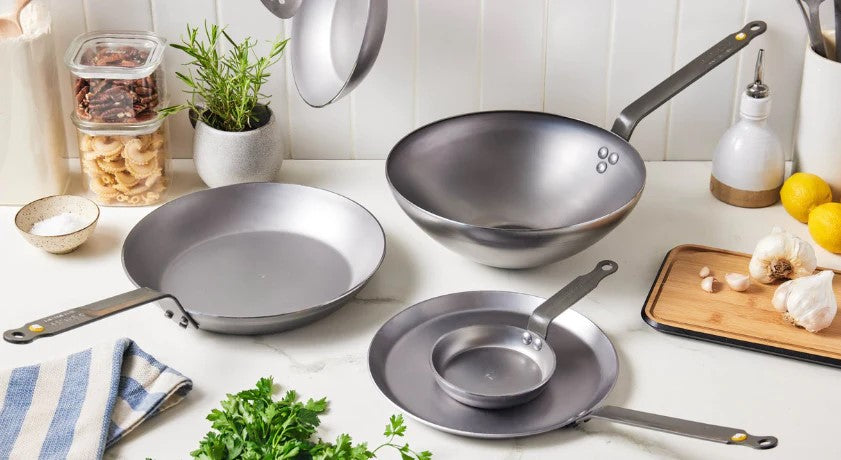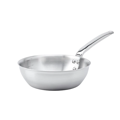Understanding the Essentials: Sauté Pan vs Frying Pan
Defining Sauté Pans and Frying Pans
When you're equipping your kitchen, understanding the difference between sauté pans and frying pans is crucial. Sauté pans and frying pans have distinct differences.
Sauté pans, with their straight sides and larger surface area, are ideal for techniques like sautéing, simmering, and braising. They often come with a lid, making them perfect for dishes that require cooking with both direct and indirect heat.
Comparing Shapes and Sizes
When you're in the market for a new pan, understanding the nuances between a sauté pan and a frying pan can make all the difference. Choosing the right fry pan size is crucial for cooking efficiency and storage space. de Buyer offers a range of sizes to match different cooking needs and enhance culinary experiences.
The shape of a sauté pan is distinct with its straight sides, which are ideal for searing and containing food easily. In contrast, frying pans have sloped sides, better suited for tossing and turning ingredients. Here's what to consider:
- The angle of the sides can affect how easily you flip or stir food.
- Weight and handle design impact how comfortable the pan is to use.
- Size matters; a pan that's too small or too large can hinder your cooking.
Remember, a pan that's about 0.5 inch larger in diameter than what you think you need can offer just that extra bit of space without being cumbersome. Whether you're cooking for two or a family, there's a size that's just right for your needs.
Evaluating Heat Distribution and Retention
When you're aiming for that perfect golden crust or a pancake cooked just right, even heat distribution is key. A pan that heats uniformly ensures your food cooks evenly, without the dreaded hot spots that can ruin a meal. This is especially important for recipes that demand precise temperature control. To test this, you might dust a pan with flour and observe how it browns over a flame; a good pan will brown the flour evenly, indicating consistent heat spread.
Heat retention is another critical factor. A pan that maintains temperature well will allow you to sear steaks or brown chicken pieces uniformly. However, be wary of pans that hold onto heat too strongly, as they can be slow to respond to temperature changes, increasing the risk of burning your food. Remember, sauté pans are deeper than frying pans with vertical sides to prevent spills, while skillets are versatile for various cooking methods. Materials like carbon steel and stainless steel are popular for their heat handling properties.
Here's a quick checklist to consider:
- Observe the pan's heat distribution with a flour test.
- Check for even searing and browning in cooking tests.
- Note the pan's response to temperature changes to assess heat retention.
Considering Versatility and Use Cases
When you're choosing between a sauté pan and a frying pan, consider the versatility each offers. A good frying pan is not just a piece of cookware; it's a multifaceted tool that can handle a variety of cooking techniques. From searing and sautéing to simmering, a frying pan can be your go-to for most tasks.
Versatility is key in a well-equipped kitchen, and frying pans excel in this area. They are suitable for cooking a small family meal, withstand high temperatures, and transition smoothly from stovetop to oven. Here are some points to ponder:
- Can the pan conduct and retain heat evenly?
- Is it easy to clean and maintain over time?
- Does it offer the convenience you need for your preferred cooking style?
Choosing the Right Material for Your Cooking Needs
Stainless Steel: Pros and Cons
When you're considering the stainless steel option for your cookware, think of it as the versatile foundation of your culinary arsenal. Stainless steel pans excel in heat conduction, especially when designed as tri-ply, which combines the quick heating of aluminum with the durability and heat retention of steel. This makes them ideal for a variety of cooking techniques, from searing to oven roasting.
However, while stainless steel is praised for its durability and ability to withstand high temperatures, it's important to note that it may require a bit more effort to maintain its shine and prevent food from sticking. Stainless steel offers superior heat conduction and retention, durability, and resistance to high temperatures, making it versatile for various cooking methods. Regular maintenance is necessary to preserve its cooking properties over time.
Carbon Steel: Caring for Traditional Pans
When you choose traditional cookware like carbon steel, you're opting for durability and versatility. These materials are renowned for their excellent heat retention and even distribution, essential for achieving that perfect sear on your meats and vegetables. To keep these pans in top shape, regular seasoning is key. This process not only maintains their cooking properties but also prevents rust, ensuring a long-lasting addition to your kitchen arsenal.
Here are a few simple care tips:
- Always hand wash and thoroughly dry your pan after use to avoid rust.
- Avoid cooking acidic foods for extended periods, as these materials are reactive.
- If needed, reseason your pan to restore its surface.
Begin Your Culinary Journey with de Buyer
The journey to finding the perfect sauté or frying pan is a personal and important culinary quest. It's not just about picking a pan; it's about choosing a companion for your cooking adventures that aligns with your cooking style, preferences, and the practical needs of your kitchen. From the versatility of a 12" sauté pan to the specific material benefits that cater to different cooking techniques, each pan has its unique role to play. Remember to consider the size, material, and compatibility with your cooking surface when making your choice. Whether you're flipping pancakes or searing steaks, the right pan can elevate your cooking from a mere task to an art form. So, take your time, weigh your options, and select a pan that will not only cook your meals but also inspire your culinary creativity.









